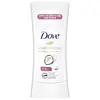What's inside
What's inside
 Key Ingredients
Key Ingredients

 Benefits
Benefits

 Concerns
Concerns

 Ingredients Side-by-side
Ingredients Side-by-side

Water
Skin ConditioningMandelic Acid
AntimicrobialMaranta Arundinacea Root Powder
Skin ConditioningTapioca Starch
Isoamyl Laurate
EmollientBehenyl Alcohol
EmollientHydrogenated Castor Oil
EmollientCaprylic/Capric Triglyceride
MaskingCaffeine
Skin ConditioningPvm/Ma Decadiene Crosspolymer
Potassium Hydroxide
BufferingGlyceryl Stearate
EmollientStearyl Alcohol
EmollientDimethicone
EmollientPanthenol
Skin ConditioningAloe Barbadensis Leaf Juice
Skin ConditioningTheobroma Cacao Seed Butter
EmollientTocopherol
AntioxidantAllantoin
Skin ConditioningStearic Acid
CleansingPalmitic Acid
EmollientCetyl Alcohol
EmollientLauryl Alcohol
EmollientMyristyl Alcohol
EmollientLecithin
EmollientPentylene Glycol
Skin ConditioningPhenylpropanol
MaskingSodium Benzoate
MaskingWater, Mandelic Acid, Maranta Arundinacea Root Powder, Tapioca Starch, Isoamyl Laurate, Behenyl Alcohol, Hydrogenated Castor Oil, Caprylic/Capric Triglyceride, Caffeine, Pvm/Ma Decadiene Crosspolymer, Potassium Hydroxide, Glyceryl Stearate, Stearyl Alcohol, Dimethicone, Panthenol, Aloe Barbadensis Leaf Juice, Theobroma Cacao Seed Butter, Tocopherol, Allantoin, Stearic Acid, Palmitic Acid, Cetyl Alcohol, Lauryl Alcohol, Myristyl Alcohol, Lecithin, Pentylene Glycol, Phenylpropanol, Sodium Benzoate
Ingredients Explained
These ingredients are found in both products.
Ingredients higher up in an ingredient list are typically present in a larger amount.
Dimethicone is a type of synthetic silicone created from natural materials such as quartz.
What it does:
Dimethicone comes in different viscosities:
Depending on the viscosity, dimethicone has different properties.
Ingredients lists don't always show which type is used, so we recommend reaching out to the brand if you have questions about the viscosity.
This ingredient is unlikely to cause irritation because it does not get absorbed into skin. However, people with silicone allergies should be careful about using this ingredient.
Note: Dimethicone may contribute to pilling. This is because it is not oil or water soluble, so pilling may occur when layered with products. When mixed with heavy oils in a formula, the outcome is also quite greasy.
Learn more about DimethiconeHydrogenated Castor Oil is created by adding hydrogen to castor oil. This helps stabilize the castor oil and raises the melting point. At room temperature, hydrogenated castor oil is solid.
Castor Oil helps moisturize the skin. It is rich in a fatty acid called ricinoleic acid. This fatty acid helps prevent moisture loss on the skin. This helps keep your skin soft and hydrated. Ricinoleic acid also has anti-inflammatory and pain reducing properties.
As a wax-like substance, Hydrogenated Castor Oil acts as an emollient. Emollients help keep your skin stay soft and smooth by creating a barrier. This barrier helps trap moisture.
Hydrogenated Castor Oil may not be fungal-acne safe. We recommend speaking with a professional.
Learn more about Hydrogenated Castor OilStearyl Alcohol is a type of fatty alcohol from stearic acid. It is a white, waxy compound used to emulsify ingredients.
Fatty Alcohols are most often used as an emollient or to thicken a product. Emollients help soothe and hydrate the skin by trapping moisture.
They are usually derived from natural fats and oils and therefore do not have the same drying or irritating effect as solvent alcohols. FDA allows products labeled "alcohol-free" to have fatty alcohols.
Learn more about Stearyl Alcohol